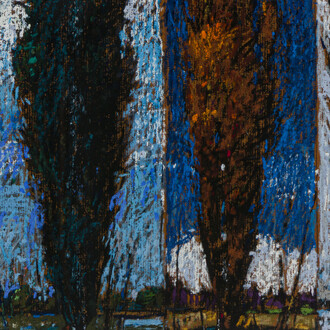Turner Carroll is proud to introduce Clarence Heyward and his work to the international art community.
Heyward has previously exhibited at the Nasher Museum of Art at Duke University, the Contemporary Art Museum of Raleigh, Harvey B. Gantt Center for Cultural Arts, the 21C Museum, and the Museum of Science and Industry in Chicago. He is a current Joan Mitchell Award nominee. Turner Carroll brings his Unseen exhibition to the global stage in an expanded version, including new works to those premiered at his Unseen exhibition in 2022 at CAM Raleigh.
Unseen is Heyward's first museum solo exhibition, its premise being what would happen to his wife and two young daughters if he was one of the black men he watches be killed on the nightly news. Heyward was driven to create Invisible Man, above, by the murder of George Floyd at the hands of police. Here, Heyward depicts himself as the victim of police brutality. "This is how the media sees us. I internalized it and I started thinking about my kids and my wife and what their future would look like without me," says Heyward.
While his work has a clear political bent, Heyward is highly interested in the personal. He is a man with strong relationship ties, and his portraits typically include friends and family members. The works convey empathy and regard for his subjects, in particular his wife and two daughters. Heyward's images of his spouse and children convey a rich sense of emotion; he has a unique ability to capture moments of interiority and introspection.
I don't want my kids to feel or know any limitations.
(Clarence Heyward)
Heyward hopes to challenge stereotypes seen in American media regarding Black fathers. "You just don't see Black men on television playing with their daughters", he explains. By creating images of his daughters, such as those seen in the Nuclear Family Series, Heyward is demonstrating his personal involvement with his girls as well as the possibility of close-knit, two-parent Black families.
Though these works are in many ways highly personal, there is a broad cultural critique embedded within each one. Heyward chooses to paint himself and his loved ones with green skin, a color that bears a great deal of cultural symbolism and creates multiple meanings within his works. The color is a nod to the preconceptions that American society projects onto Black people, the same way images are added to green screens to create special effects on television and film. The color also produces a more positive message in Heyward's work. Art critic Charles Moore writes that the color green evokes a sense of "growth and renewal", and by choosing to render his subjects in this palette, Heyward is creating a sense of optimism and hope for their future.
In addition to his use of the color green, Heyward employs a number of weighted symbols in order to interrogate cultural stereotypes in the United States. Branching into sculpture, he has created a picket fence, an emblem of American suburban utopia. Heyward's fence, however, is not the pure white color seen in popular culture; it is scuffed, smeared with dirt and grass stains. The work challenges the widespread idealization of middle class American life, showing the viewer that reality is more complicated than what meets the eye.
Turner Carroll is thrilled to bring Heyward's uncompromising, compassionate, often witty perspective to Santa Fe and the American West.
















